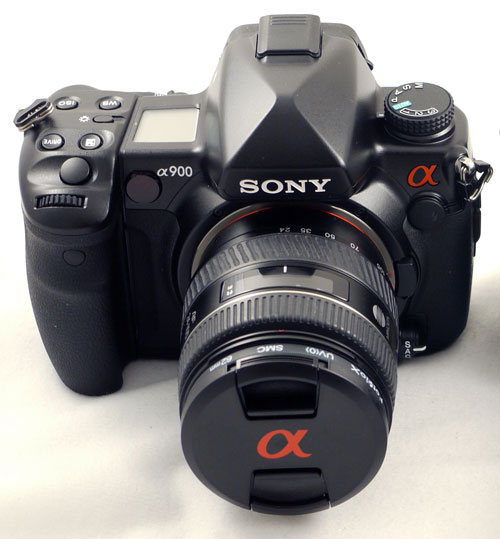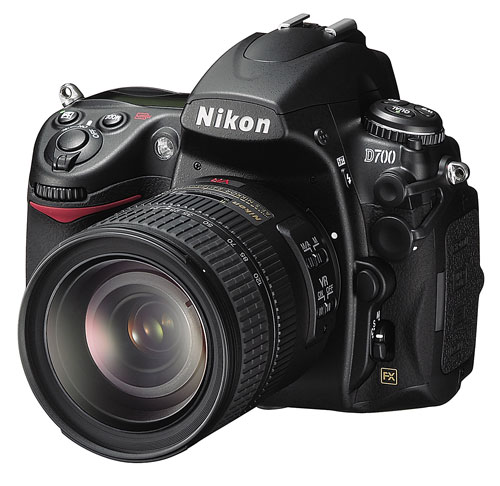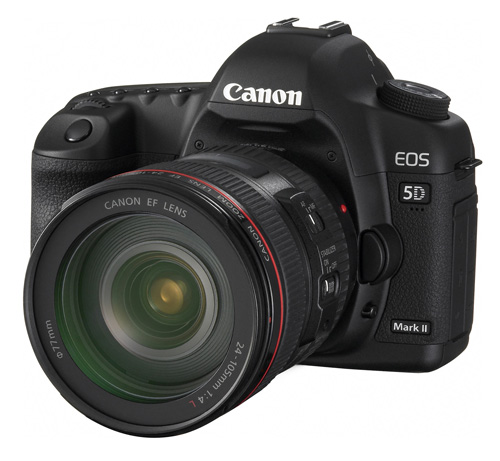Digital Cameras for the Holidays
by Wesley Fink on November 27, 2008 12:00 AM EST- Posted in
- Digital Camera
Full-Frame DSLRs
Just over a year ago we were predicting that the professional DSLR market would likely move completely to the full-size digital sensor. The speed with which this has actually happened is pretty impressive. A little over a year ago only Canon played alone in the full-frame arena, and their top selling full-frame pro model, the 1DS Mark II, was selling for $8000. Now just over a year later the top three camera manufacturers - Canon, Nikon, and Sony - all have full-frame offerings, and all of them have full-frame models that sell for $3000 or less.

Since acquiring Minolta, Sony has been aiming for more respect in the camera industry. A key part of that strategy was the launch of a full-frame Sony DSLR, which finally happened in the last couple of months. The new Sony A900 is not just another offering either, but a new full-frame solution. First, it features the highest resolution full-frame sensor you can buy with the 24.6MP Sony sensor. Pundits said Sony couldn't make a full-frame with Image Stabilization in the body, but that is exactly what they did. Steady Shot works great and makes any of the multitude of Sony and Minolta lenses that mount on the A900 image stabilized.
There is also the viewfinder. If anyone doubted Sony in the optics department they have only to look through the 100% view of the A900 viewfinder to be reminded again what optics and full-frame are all about. In fact, the Sony viewfinder is clearly the best, biggest, and brightest you will find in any current DSLR.
The A900 is not without its issues, however. 24.6MP is an incredible amount of detail, but noise starts to become a problem at ISO 1600. Everyone would like to see lower noise at the higher ISOs, but the detail captured at the highest ISOs, even with higher noise, is still very impressive. Sony has a huge lens lineup, mostly brought over direct form Minolta, but many of these designs could use a refresh. Also in terms of continuous speed, Sony, with all their mirror innovations like parallel link, still falls in the middle at 5 FPS between the super-high speed 9 FPS D3 and the new 3.5 FPS Canon 5D Mark II.

The Nikon D700 is the new cheaper Nikon full-frame designed to compete with the Sony A900 and the Canon 5D Mark II. When it launched just a few months ago it had no real peers, but now that the 24.6MP Sony A900 is shipping and the Canon 5D Mark II is 21.1MP, the Nikon line is starting to look like a new full-frame should be on the way. Nothing we have tested rivals the incredible low noise of the Nikon sensor, and D700 speed with the right battery is a blistering 8 FPS.

On paper, the Canon 5D Mark II looks like the one to beat in this category. After all Canon was first to offer a full-frame at the low price of around $3000 over three years ago, and Canon themselves proclaim the new 5D Mark II sensor the most advanced they make - better even than the $8000 1Ds Mark III. After the 50D failed to impress as completely as many expected of a 15.1MP Canon, most are waiting until the 5D Mark II production models start landing next week to decide how good they are.
The 5D Mark II updates everything to the very latest thinking in digital technology, including the two Live View modes, and a new twist that will likely be just the beginning of a revolution in the DSLR market. The Canon 5D Mark II also features a true 1080i HD movie mode that is pretty impressive in the early samples Canon has released. This true HD movie capability also auto-focuses. 21.1MP on a full-frame sensor means much bigger pixels than 15.1MP on a 1.6X crop sensor, so high hopes abound. Canon had the guts to include 25600 as an ISO speed option on the new 5D, matching the Nikon D3 and D700 in top ISO speed. If it is close to as good as the Nikon full-frames at high ISO it will not be long until you will see a Nikon D3x. You can be sure a Canon 1Ds Mark IV is also on its way early next year.
It is impossible to make a recommendation in the full-frame category because each camera in the group excels in different areas, and the decision will be based on your needs and the lens system you now use or choose. The Sony delivers the highest resolution any reviewer has ever tested, speed is good, and the viewfinder is the best. Ergonomics and ease-of-use are superb, but it is weak in high ISO noise at this point - which possibly will be much improved (as in the A700) with future firmware updates. The Nikons have the best High ISO performance and speed, but with half the resolution of the Sony A900. Still, for action or sports nothing comes close to the speed of the Nikon full-frames. The Canon 5D Mark II is the slowest of the group on continuous speed, but resolution may come close to the Sony and high ISO performance could be equal or near the Nikon full-frames.
We will soon have more answers to the question of which full-frame is "best", but the market niches that each of these three target will still likely make them three very different solutions for the full-frame market.










41 Comments
View All Comments
Wesley Fink - Friday, November 28, 2008 - link
We;ve added mention of the Pentax K20D as a great value at $750 to $800 in the Prosumer category. It is not, however, without its probelms, as is true of any camera, and the price has dropped from $1295 to $750 in pretty short order. Its an outstnding value if it fits your needs and the way you shoot.ubiloo - Friday, November 28, 2008 - link
Sorry, I meant 'for at least €100 less'computerfarmer - Thursday, November 27, 2008 - link
If I were to choose.......from this article.Point and shoot:
Panasonic Lumix DMC-L8 for quality, Canon Powershot A590 IS best for the money.
Super Zoom:
Panasonic Lumix LMC-TZ5
Entry Interchangeable Lens:
Canon XSi or XS and Panasonic G1
At this level, all make decent products....hard to choose.
Prosumer:
Nikon D90 or Canon 50D ....hard to choose.
Full-Frame:
Nikon D700 or Canon 5D Mark II
I am about to enter the "Entry Interchangeable Lens" category, perhaps in March or April. I have gone from point and shoot to superzoom. Panisonic FZ8 is camera I have now. It is so much better than the point and shoot. But the cost to go up to the next level is quite substantial. With a kit lens, I will not get the zoom I am accustomed too. The macro part I am unsure of. Then there is the flash. The number one reason for upgrading is the quality of photograph. The question I have is, if I wanted to print 13x19 inch photos, what camera and lens would do the best job for, Portraits, Birds, Indoors....
Example: If I purchased a Canon Rebel XSi; what else would I need to get the most out of this camera(general use). I am thinking the camera with the kit lens, plus a 200mm zoom lens, a macro lens, a flash(wireless would be nice), a good tripod. how much would this cost me?
This article gave a good overall view.....Thank You
strikeback03 - Monday, December 1, 2008 - link
Unless the birds are very tame, 200mm isn't very long. A friend of mine has the XTi with 18-55IS/55-250IS combo though and is very happy with them for general use. The 55-250IS is not that expensive, B&H has a kit with XSi/18-55IS/55-250IS for $708. The 100/2.8 Macro is a good macro lens and also very usable for tighter portraits, runs around $450. No Canon bodies offer wireless flash control in-body, so the flash itself ranges from $200-400 depending on power and features, and if you want wireless you either need remote triggers and external metering, or a ST-E2 wireless transmitter. Tripods are highly dependent on what you want and need, but guessing at least $100 is pretty safe.Note that for some items (lenses, flash) you can sometimes find third-party alternatives which work as well for your needs for less money.
haplo602 - Friday, November 28, 2008 - link
have a look on ebay ...I don't know the canon line of lenses, but something similar to the AF-S DX NIKKOR 18-105mm f/3.5-5.6G ED VR will make a good all-around starter lens.
Maxington - Thursday, November 27, 2008 - link
The G1 is revolutionary alright, its a camera that does away with the mirror box and optical viewfinder, without actually being any smaller than standard DSLRs!Why is this article have such a huge positive bias towards it? It should be applauded for actually trying, but totally dismissed until, like the rest of the 4/3rds range, it actually delivers on making a camera small. How you can recommend it whatsoever is beyond me.
Hell, Pentax have a far smaller setup, with the K2000/Km body, and their pancake lens range. And a better performing sensor with a bigger lens range to boot.
Speaking of Pentax, why were no Pentax cameras recommended? They are far better value for money than Nikon/Canon, though Sony camera bodies are probably the best value, pity their lenses are ridiculously priced.
Wesley Fink - Friday, November 28, 2008 - link
The G1 is a great deal smaller overall than any DSLR we have tested, but it also has many other features going for it, like the superb 3 inch tilt-and swivel hi-res LCD and the first EVF we could actually live with. It also breaks new ground in Live View AF.We agree the Pentax K20D is a great value at $750 to $800, and mention of the K20D has been added. It should also be mentioned that the price of the K20D has declined from $1295 to $750 in pretty short time. The pro-type sealing and 14.6 megapixel sensor are top of the class, but the high ISO noise, inconsistent color at high ISO, slow AF, and slow continuous frame-rates detract from the top-notch features.
gaston1 - Friday, November 28, 2008 - link
Thank you for adding K20D to the list. I agree about the AF being slower than the competition. High ISO noise, not really, I'd say it's in line with other APS-C cameras in its range, although Pentax has taken a different approach, producing grainier pictures at high ISO but preserving much more detail than the others (and can be cleaned very easily through software if one chooses to). ISO 1600 is very useable, 3200 is sort of equivalent to the K10D's 1600, not that clean but useful when needed, and the 6400 is not that useable, in my opinion. We must also not forget that most reviews (comparing jpegs) will have Pentax tested on its default setting with noise reduction off while it kicks in by default on other cameras once you start using higher ISO settings. Canon's ISO 12800 hardly contains any detail at all, and in my opinion is just there for marketing purposes.As far as value goes, Pentax shines when you start considering lenses. I strongly considered going for the Nikon D700 or even waiting for the Canon 5D mkII, both great cameras for low light (or landscape) photography. But after researching the lenses that I would need, the system price was quickly stretching far beyond my amateur's budget (although still a bargain if you're a pro and need the features). I even briefly considered Sony's A900 but had a similar issue with the cost of lenses.
strikeback03 - Monday, December 1, 2008 - link
I don't really see the advantage in Pentax lens prices that you mention. Seems like they have dropped some, as a year ago I initially recommended a K10D with 16-50 2.8 to a friend, expecting the 16-50 to be around $500. I was shocked to see it was around $900 at the time. At least now it is more reasonable. Checking other similar lenses they seem to be mostly in line with Canon/Nikon, with some deals (50/1.4 for $200) and some more expensive (the 77/1.8 vs 85/1.8 from others).Maxington - Friday, November 28, 2008 - link
Echoing what gaston1 said, thanks for adding the K20D to the list.Also echoing the high iso comment, Pentax has higher noise due to it retaining detail and not smearing it away like Nikon/Canon do. I'd rather keep the detail and post-process it later, with much better tools, than let the camera do it.
http://www.dpreview.com/reviews/pentaxk20d/page18....">http://www.dpreview.com/reviews/pentaxk20d/page18....
Look at the mush the others turn into.
I'm still not convinced the minor size drop the Panasonic G1 has makes it worthwhile. (It's about half a cm shorter than the Pentax Km, and about 2cm thinner) It's not small enough to drop into "pocket" range, especially with the lack of pancake lenses, thus any size benefit it has is pretty much pointless. It's still a DSLR to carry. When they get it down to being like a rangefinder, then it'll be worth looking at.
I do like the back lcd and the slick contrast af though.